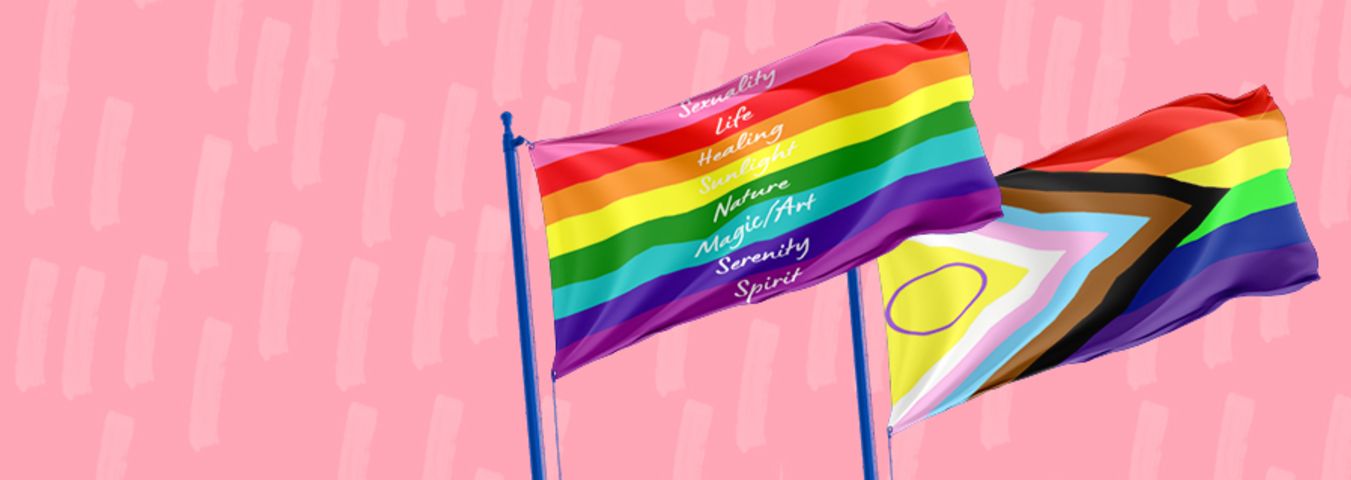Know Your Pride Flags
Colourful and Proud!
To celebrate Pride Month, we thought we’d help you brush up on your knowledge of the colourful range of flags that make up the vibrant LGBTQ+ community, and learn the history behind each one. As an ever evolving and growing community, new LGBTQ+ flags will surely fly onto the scene over the coming months and years so this isn’t a complete list (although we tried!). We’re ready and waiting to welcome more to the party, and as always, happy Pride!
Gilbert Baker Pride Flag

An instrumental figure in the creation of the modern LGBTQ+ movement, American artist and gay rights activist Gilbert Baker gave us this bold and colourful flag in the late 70s. First showcased at the San Francisco Gay and Lesbian Freedom Day Parade on June 25 1978, it’s the first flag to celebrate the diversity and joy of the LGBTQ+ community. Baker picked each colour to represent something specific: pink for sexuality, red for life, orange for healing, yellow for sun, green for nature, turquoise for magic/art, blue for serenity/harmony and purple for spirit/soul.
Traditional Pride Flag

So this is probably one of the Pride flags you’re most familiar with, and this beauty hit the scene in 1979. A slightly modified version of Baker’s original, it features six colours instead of eight. Legend has it that the flag was made because pink material was too difficult to get at the time, and the turquoise strip was removed because they wanted to keep an even number of colours.
More Colour, More Pride Flag

Exactly what it says on the tin: more colour, more pride. In 2017, Philadelphia-based ‘More Colour More Pride’ unveiled this new 8-striped flag to better represent the entire LGBTQ+ community, including people of colour. Amber Hikes, one of the developers of the flag, explained the importance of the new stripes, “this 8-stripe flag is not a replacement for the 6-stripe flag. It is a way to symbolise, to highlight, and to stand in solidarity with these other identities.”
Transgender Pride Flag

Debuted at a 2000 Pride parade in Phoenix, the Transgender Pride flag is a vision in blue, pink and white. Designed by Monica Helms, a transgender woman, the five stripes represent baby blue for boys, baby pink for girls, and the white stripe in the middle for all those transitioning or who don’t identify with the two gender binaries.
Genderqueer Pride Flag

Marilyn Roxie, a genderqueer writer and activist, designed this flag in 2011 and it features stripes of lavender, white and chartreuse. The lavender band represents androgyny (purple being a combination of blue and pink, the traditional colours attached to male and female genders), the white stripe is for those who identify as agender or gender neutral and the final green band is for all the people who don’t identify with the gender binaries at all.
Genderfluid Pride Flag

This beautiful flag was created to celebrate the genderfluid community, and challenge the ideas that gender is a concrete and unchangeable part of someone’s identity. Created by JJ Poole, the combination of colours stand for all the different aspects of gender: femininity (pink), masculinity (blue), purple (both femininity and masculinity), black (non gender specific) and white (all genders).
Non-Binary Pride Flag

Designed by Kye Rowan (who was 17 at the time) to act as a partner flag to the Genderfluid Pride flag to better represent all aspects of the community. This one features four stripes: yellow for genders that exist outside the binary, white for people who identify with many or all genders, purple for people who see their gender a mix of both female and male and black for those who feel no particular attachment to any gender.
Agender Pride Flag

Salem X, the designer of this flag, credits its creation to the “huge influx of identities, pronouns and other means of personalising one’s identity” that had emerged by 2014. The black and white stripes represent an absence of gender, the grey stripes stand for semi-genderlessness and the central lime green stripe is to celebrate non-binary genders.
Demisexual Pride Flag

The term demisexual means someone who only feels sexually attracted to someone when they have an emotional bond with the person. They can be gay, straight, bisexual, or pansexual, and may have any gender identity. The original thinking behind the colour choices is unknown, but they are commonly thought to represent asexuality (black), demisexuality (grey), sexuality (white) and community (purple).
Polyamory Pride Flag

Jim Evans designed this flag in 1995 to represent the polyamorous community, people who have multiple honest and intimate relationships at the same time with consent. With three main colour blocks, blue (honesty and openness), red (love and passion) and black (solidarity), and with a yellow symbol in the centre. Now, if you remember your GCSE maths, you should recognise this as our old friend pi. Chosen because it’s a never ending number, representing the endless possibilities for love within polyamory.
Lesbian Pride Flag

The more well known of the two flags and widely accepted as the official Lesbian Pride flag, we have this stunner in red, orange, white and pink. What a palette! Designed by Emily Gwen, the colours stand for gender non-conformity, independence, serenity & peace, love & sex, community, unique relationships to womanhood, and femininity.
Bisexual Pride Flag

This flag was created to increase the visibility and inclusion of the bisexual community within the greater LGBTQ+ one. An often marginilised sub-section of the wider group, LGBTQ+ activist Michael Page designed it to give bisexual people their own defined symbol to stand behind. Made up of three bold colours, first we have magenta (standing for same-sex attraction), deep blue (for attraction to a different gender) and lavender, a mixture of magenta and blue (representing attraction across the entire gender spectrum).
Pansexual Pride Flag

With a similar three striped design to the Bisexual Pride flag, the Pansexual Pride flag was created to represent those who identify as pansexual (people who are attracted to others regardless of gender). Pink is for attraction to women, blue for men, and yellow for those who don’t sit within the gender binary.
Polysexual Pride Flag

The term polysexual refers to people who are attracted to multiple genders, but not necessarily all of them. Borrowing from the Pansexual and Bisexual Pride flags, the colours here represent the same three things: pink for women, blue for men and green for non-binary. The flag was designed in 2012 by Samlin, a Tumblr user, who made it similar to the pansexual and bisexual flags “since they’re all in under the multisexual umbrella”.
Intersex Pride Flag

This flag was designed in 2013 to celebrate the intersex community, and uses the colours yellow and purple as they are widely considered to be the most gender neutral. Morgan Carpenter who created the flag, explains the symbolism as ‘the circle is unbroken and unornamented, showing wholeness and completeness. We are still fighting for bodily autonomy and gender integrity, and this symbolises the right to be who and how we want to be.”
Aromantic Pride Flag

Created with a similar colour scheme to Salem’s Agender flag, this design represents those who have little or no romantic attraction to others.
Asexual Pride Flag

The Asexual Pride flag was designed in 2010 by the Asexual Visibility and Education Network, this flag has bands of black (for asexuality), grey (for grey-asexuals and demisexuals), white (representing allies) and purple (representing community), and was created for the community of people who have little or no sexual attraction to others.
Progress Pride Flag

The final flag on our list (for now at least) is another variation on the rainbow flag you might already be familiar with is the Progress Pride flag. Updated in 2018, the addition of the arrow stripes was to better celebrate the incredible trans community and queer people of colour, whilst honouring those who lost their lives due to AIDS complications. Created by graphic designer and activist Daniel Quasar, his goal for the new flag was to “shift focus and emphasise what’s important in our current community climate.”
To explore our entire Pride cards & gifts range, click here.

Moonpig

